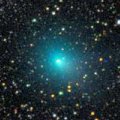
|
Now it is so bright as 8.3 mag (May 3, Seiichi Yoshida). It will be observable at 8-9 mag in good condition from April to May. After that, it keeps observable for a long time until when it fades out in the Northern Hemisphere, although it will be low in July.
Date(TT) R.A. (2000) Decl. Delta r Elong. m1 Best Time(A, h)
May 1 20 59.42 68 29.5 1.328 1.422 73 8.3 5:10 (187,-14)
May 8 21 57.37 76 45.3 1.408 1.427 70 8.4 5:15 (186,-23)
|

|
It has been unobservable for a while, but now it is appearing in the morning sky. Now it is 10.0 mag, much brighter than originally expected (Apr. 25, Marco Goiato). It will approach to the sun down to 0.4 A.U. in July, and it is expected to reach up to 2-3 mag. In the Northern Hemisphere, it is observable only until June.
Date(TT) R.A. (2000) Decl. Delta r Elong. m1 Best Time(A, h)
May 1 23 29.35 8 8.9 1.961 1.440 45 9.9 5:10 (242, 22)
May 8 23 45.46 12 30.0 1.783 1.318 46 9.2 5:15 (236, 22)
|
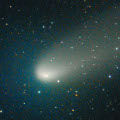
|
It reached up to 9.2 mag in March (Mar. 20, Marco Goiato). Now it is fading, but still bright as 9.8 mag (May 3, Marco Goiato). It keeps observable in a good condition for a long time. It keeps observable until autumn when it fades down to 16 mag.
Date(TT) R.A. (2000) Decl. Delta r Elong. m1 Best Time(A, h)
May 1 14 5.84 -4 42.5 0.732 1.730 167 10.3 23:28 (180, 60)
May 8 14 3.90 -4 44.4 0.769 1.757 161 10.5 22:59 (180, 60)
|

|
It reached up to 7.7 mag in last summer (Aug. 13, Chris Wyatt). It is fading now. It has already faded down to 11.7 mag (Apr. 25, Marco Goiato). In the Southern Hemisphere, it keeps observable for a long time after this. But in the Northern Hemisphere, it is only observable in the low sky in spring, then it will never be observable again.
Date(TT) R.A. (2000) Decl. Delta r Elong. m1 Best Time(A, h)
May 1 20 14.64 -32 37.4 3.890 4.209 101 11.4 5:10 (251, 83)
May 8 20 10.38 -34 6.4 3.811 4.251 109 11.4 5:08 (180, 89)
|
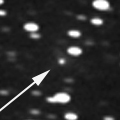
|
Now it is 13.5 mag (Apr. 22, A. Novichonok, D. Chestnov). It is getting brighter rapidly in the morning sky. It keeps observable bright as 9-10 mag for a long time from spring to autumn.
Date(TT) R.A. (2000) Decl. Delta r Elong. m1 Best Time(A, h)
May 1 20 43.47 -10 35.9 1.210 1.574 89 11.9 5:10 (212, 62)
May 8 21 3.91 -9 57.5 1.141 1.545 91 11.5 5:15 (206, 63)
|
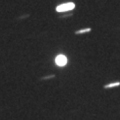
|
Bright new comet discovered as a bright stellar object of 12.5 mag on Apr. 16. It was not detected, fainter than 20 mag, on the previous day (Apr. 15, Catalina Sky Survey). It was discovered just after the sudden outburst. It is bright as 11.7 mag still now (May 2, Seiichi Yoshida). The coma is expanding up to 2 arcmin.It keeps observable good condition for a while. The coma will be expanding rapidly after this.
Date(TT) R.A. (2000) Decl. Delta r Elong. m1 Best Time(A, h)
May 1 13 28.59 4 42.1 2.176 3.118 154 12.4 22:51 (180, 50)
May 8 13 24.22 4 29.6 2.216 3.120 148 12.4 22:19 (180, 51)
|
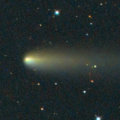
|
It brightened up to 9.5 mag on Jan. 13 (Juan Jose Gonzalez). Now it is fading rapidly. But it is still bright as 12.6 mag (May 3, Seiichi Yoshida). It will be observable in good condition for a long time after this in the Northern Hemisphere. It keeps visible visually until summer. In mid March, the nuclear fragmentation was observed.
Date(TT) R.A. (2000) Decl. Delta r Elong. m1 Best Time(A, h)
May 1 15 0.34 63 58.4 2.854 3.201 100 12.4 0:27 (180, -9)
May 8 14 53.85 64 1.4 2.939 3.253 99 12.6 23:48 (180, -9)
|

|
It brightened up to 15.5 mag in January (Jan. 31, C. Rinner, F. Kugel). It is not observable now. The condition of this apparition is bad. It will reach up to 11-12 mag from spring to autumn, but it is not observable.
Date(TT) R.A. (2000) Decl. Delta r Elong. m1 Best Time(A, h)
May 1 2 17.95 19 21.0 2.523 1.523 5 12.6 5:10 (258,-18)
May 8 2 40.47 20 24.3 2.492 1.490 5 12.4 5:15 (256,-16)
|

|
It became very diffuse with no condensation on Mar. 12 (Hidetaka Sato). This comet seems to have already stopped its cometary activity. Only very faint remnant like a ghost is detected now. However, it is still reported so bright as 10.7 mag visually (Apr. 16, Marco Goiato). In the Northern Hemisphere, it will be too low in early May. In the Southern Hemisphere, it keeps observable for a long time after this, but it keeps locating low.
Date(TT) R.A. (2000) Decl. Delta r Elong. m1 Best Time(A, h)
May 1 5 21.90 9 15.3 1.515 1.018 41 12.9 18:43 (116, 19)
May 8 5 34.66 5 24.7 1.684 1.115 39 12.9 18:37 (112, 20)
|

|
Now it is visible visually at 13.4 mag (Mar. 25, Chris Wyatt). It will brighten up to 12-13 mag in summer. But it locates somewhat low in the Northern Hemisphere.
Date(TT) R.A. (2000) Decl. Delta r Elong. m1 Best Time(A, h)
May 1 20 42.15 -25 3.5 2.184 2.468 94 13.2 5:10 (235, 74)
May 8 20 50.25 -25 11.3 2.108 2.475 98 13.1 5:15 (218, 78)
|
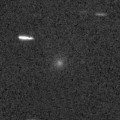
|
Bright new comet discovered at 11 mag in the extremely low sky at dawn. Now it is 10.7 mag (Mar. 27, Juan Jose Gonzalez). It was observed only about one week. It will never be observable again.
Date(TT) R.A. (2000) Decl. Delta r Elong. m1 Best Time(A, h)
May 1 3 1.80 17 12.2 1.800 0.812 7 13.4 18:43 (102,-13)
May 8 3 23.52 13 31.9 1.904 0.910 6 14.0 18:37 ( 99,-11)
|

|
Chris Wyatt reported it was visible visually at 11.3 mag on Apr. 25. But no other observations have been reported. The condition of this apparition is very bad. It locates in the extremely low sky at dawn only. It will be unobservable after May.
Date(TT) R.A. (2000) Decl. Delta r Elong. m1 Best Time(A, h)
May 1 0 44.16 12 2.4 1.681 0.898 26 14.3 5:10 (251, 5)
May 8 1 20.90 15 4.3 1.664 0.842 23 13.6 5:15 (250, 3)
|

|
Great outburst up to 11 mag occured on Feb. 2. Another new minor outburst occured up to 12.7 mag on Apr. 16 (Albert Sanchez Caso). It is bright as 11.3 mag still now (May 3, Seiichi Yoshida).
Date(TT) R.A. (2000) Decl. Delta r Elong. m1 Best Time(A, h)
May 1 9 17.26 13 14.9 6.000 6.208 97 13.8 18:43 (179, 42)
May 8 9 18.57 13 7.1 6.112 6.209 90 13.9 18:37 (173, 42)
|
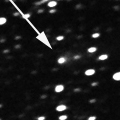
|
Now it is visible visually at 14.5 mag (Mar. 15, Juan Jose Gonzalez). It keeps observable for a long time until September when it becomes fainter than 18 mag.
Date(TT) R.A. (2000) Decl. Delta r Elong. m1 Best Time(A, h)
May 1 16 10.30 -30 45.7 0.759 1.716 152 14.7 1:36 (180, 86)
May 8 16 11.96 -30 23.3 0.744 1.723 158 14.7 1:10 (180, 85)
|
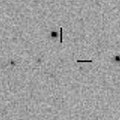
|
It was observed as 15.6 mag at the end of last year (Dec. 6, A. Maury, J. B. de Vanssay, F. Mallia, F. Kugel). It will be 14 mag from winter to spring in 2010. But the condition is bad. Now it is not observable. In the Northern Hemisphere, it will appear in the morning sky at 15 mag in late May, then it keeps observable while fading gradually after that.
Date(TT) R.A. (2000) Decl. Delta r Elong. m1 Best Time(A, h)
May 1 1 23.94 25 13.3 2.787 1.863 18 14.8 5:10 (246,-10)
May 8 1 38.20 28 16.0 2.793 1.893 21 14.9 5:15 (241, -9)
|

|
Bright new comet. Now it is 13.2 mag (Apr. 5, Juan Jose Gonzalez). It will become low in the evening sky very rapidly, and it will not be observable in early May.
Date(TT) R.A. (2000) Decl. Delta r Elong. m1 Best Time(A, h)
May 1 5 18.84 11 28.8 1.866 1.284 40 14.9 18:43 (117, 17)
May 8 5 33.78 7 47.9 1.950 1.325 38 15.2 18:37 (113, 18)
|

|
The condition of this apparition is very bad. It will go away without any observations.
Date(TT) R.A. (2000) Decl. Delta r Elong. m1 Best Time(A, h)
May 1 3 42.84 17 59.5 2.104 1.181 17 15.0 18:43 (108, -5)
May 8 4 11.32 18 44.1 2.105 1.180 17 15.0 18:37 (110, -5)
|

|
Now it is 15.5 mag (Feb. 20, S. Plaksa, E. Bryssinck). It is also visible visually at 14.5 mag (Apr. 10, Juan Jose Gonzalez). It keeps observable at 15 mag for a long time in 2010.
Date(TT) R.A. (2000) Decl. Delta r Elong. m1 Best Time(A, h)
May 1 18 4.38 32 38.9 4.226 4.674 110 15.3 3:30 (180, 22)
May 8 18 3.52 34 13.9 4.178 4.660 112 15.3 3:02 (180, 21)
|
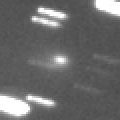
|
It became bright more rapidly than expected. Now it is 14.8 mag (Apr. 6, Catalina Sky Survey). It will be visible visually. It keeps 15 mag for a while. But it will be getting lower gradually in the evening sky.
Date(TT) R.A. (2000) Decl. Delta r Elong. m1 Best Time(A, h)
May 1 6 12.09 33 38.1 2.052 1.652 52 15.3 18:43 (142, 9)
May 8 6 36.64 33 42.7 2.102 1.669 51 15.3 18:37 (143, 9)
|

|
It brightened up to 11 mag in spring and summer in 2009. Appearing in the morninig sky again. Now it is 16.7 mag (Apr. 23, Hidetaka Sato). It keeps observable after this until autumn when it becomes fainter than 18 mag while fading gradually. But it locates somewhat low in the Northern Hemisphere.
Date(TT) R.A. (2000) Decl. Delta r Elong. m1 Best Time(A, h)
May 1 20 6.79 -24 24.2 2.498 2.876 101 15.3 5:10 (206, 78)
May 8 20 9.98 -24 25.3 2.431 2.902 107 15.4 5:08 (180, 79)
|
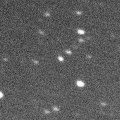
|
Now it is 15.6 mag (Apr. 11, John Drummond). It keeps bright as 14-15 mag for a long time after this until 2013. It is observable in good condition in the Southern Hemisphere. However, it is not observable in the Northern Hemisphere.
Date(TT) R.A. (2000) Decl. Delta r Elong. m1 Best Time(A, h)
May 1 15 26.55 -47 12.1 6.146 7.002 145 15.4 0:53 ( 0, 78)
May 8 15 20.09 -47 36.5 6.087 6.972 149 15.4 0:19 ( 0, 77)
|

|
Now it is 15.3 mag (Mar. 26, P. Concari, S. Foglia, G. Galli, M. Tombelli). It was observed as 15-16 mag in early 2009. In 2010, it will be observable at 16 mag in good condition from winter to spring.
Date(TT) R.A. (2000) Decl. Delta r Elong. m1 Best Time(A, h)
May 1 13 30.66 -2 0.5 2.717 3.680 160 15.5 22:53 (180, 57)
May 8 13 26.89 -1 50.8 2.760 3.686 152 15.5 22:22 (180, 57)
|

|
It became visible visually at 13.3 mag in winter (Feb. 3, Marco Goiato). Now it is fading slowly. It will be getting lower in the evening sky after this. It will be too low to observe in July.
Date(TT) R.A. (2000) Decl. Delta r Elong. m1 Best Time(A, h)
May 1 7 21.20 24 33.7 2.016 1.887 68 15.6 18:43 (151, 24)
May 8 7 38.46 24 17.2 2.078 1.891 65 15.7 18:37 (150, 24)
|
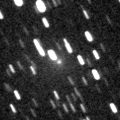
|
Now it is 15.1 mag (Apr. 3, Ken-ichi Kadota). It has a very faint large coma. It was observed so bright as 13.5 mag in January (Jan. 16, Michael Jager).
Date(TT) R.A. (2000) Decl. Delta r Elong. m1 Best Time(A, h)
May 1 8 38.12 73 5.2 1.424 1.535 76 15.6 18:43 (177,-18)
May 8 9 38.13 68 41.3 1.444 1.576 77 15.8 18:37 (180,-13)
|
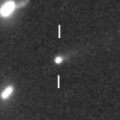
|
Now it is 15.6 mag (Mar. 17, Toshiyuki Takahashi). It was expected to be observable at 15 mag in good condition from winter to spring. But actually, it had been much fainter than expected until January. However, it is brightening very rapidly in February.
Date(TT) R.A. (2000) Decl. Delta r Elong. m1 Best Time(A, h)
May 1 10 19.10 18 57.3 1.709 2.251 109 15.7 19:42 (180, 36)
May 8 10 24.96 17 58.0 1.787 2.257 104 15.9 19:21 (180, 37)
|
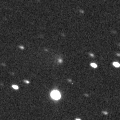
|
Now it is 16.9 mag (Jan. 9, Ken-ichi Kadota). Brightening more slowly than expected. It will be observable at 13-14 mag for a long time from 2011 to 2012. It is getting higher gradually after this. In 2010, it is observable at 15-16 mag in good condition from spring to autumn.
Date(TT) R.A. (2000) Decl. Delta r Elong. m1 Best Time(A, h)
May 1 22 0.38 1 29.4 7.656 7.343 68 15.9 5:10 (228, 42)
May 8 21 59.86 1 41.0 7.506 7.308 74 15.9 5:15 (219, 46)
|

|
It brightened up to 11.5 mag in January (Jan. 12, Juan Jose Gonzalez). Now it is fading. It has already faded down to 14.9 mag (Apr. 9, E. Bryssinck, A. Novichonok, D. Chestnov). It will be getting fainter and lower rapidly after this. It will be unobservable in June.
Date(TT) R.A. (2000) Decl. Delta r Elong. m1 Best Time(A, h)
May 1 7 44.53 19 38.4 2.239 2.190 74 16.1 18:43 (154, 31)
May 8 7 58.05 19 25.5 2.334 2.213 70 16.2 18:37 (152, 30)
|

|
It brightened up to 13 mag and observed visually from 2007 to 2009. Due to the far distance, it is bright as 14.8 mag still now (Apr. 7, E. Bryssinck, A. Novichonok, D. Chestnov, L. Elenin). It will be observable in good condition again until spring.
Date(TT) R.A. (2000) Decl. Delta r Elong. m1 Best Time(A, h)
May 1 12 0.58 42 51.2 7.653 8.094 112 16.5 21:23 (180, 12)
May 8 11 55.48 42 38.7 7.774 8.127 107 16.6 20:50 (180, 12)
|
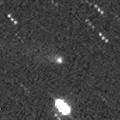
|
Now it is 16.5 mag (Apr. 17, Hiroshi Abe). It keeps observable in good condition for a while, but it will be fading after this. It will be fainter than 18 mag in July.
Date(TT) R.A. (2000) Decl. Delta r Elong. m1 Best Time(A, h)
May 1 12 33.05 26 45.1 2.813 3.538 129 16.8 21:55 (180, 28)
May 8 12 20.42 25 32.8 2.934 3.580 122 16.9 21:15 (180, 30)
|

|
It brightened up to 13 mag in major outburst in 2005. It was recovered at 20.7 mag in 2009 January. However, no observations have been reported after 2009 April. The current brightness is quite uncertain.
Date(TT) R.A. (2000) Decl. Delta r Elong. m1 Best Time(A, h)
May 1 12 58.66 -21 22.1 2.374 3.325 156 17.2 22:21 (180, 76)
May 8 12 53.90 -20 46.4 2.385 3.299 150 17.2 21:49 (180, 76)
|

|
Now it is 17.2 mag (Apr. 10, Hidetaka Sato). It was observed at 17.5 mag in 2009 spring. It will be observable at 17.5 mag again in 2010 spring. However, it locates low in the Northern Hemisphere.
Date(TT) R.A. (2000) Decl. Delta r Elong. m1 Best Time(A, h)
May 1 13 33.05 -18 1.4 5.011 5.992 165 17.3 22:55 (180, 73)
May 8 13 30.64 -17 1.4 5.049 6.002 158 17.3 22:25 (180, 72)
|
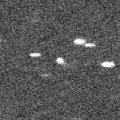
|
Now it is 17.7 mag (Mar. 21, Hidetaka Sato). It will reach up to 17 mag in spring and summer.
Date(TT) R.A. (2000) Decl. Delta r Elong. m1 Best Time(A, h)
May 1 21 1.15 -4 17.8 3.290 3.340 84 17.3 5:10 (214, 54)
May 8 21 4.68 -5 10.5 3.199 3.356 90 17.3 5:15 (203, 58)
|
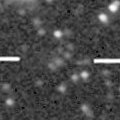
|
Now it is 17.3 mag (Jan. 23, Ken-ichi Kadota). It keeps observable at 17.5 mag in good condition for a long time in 2010.
Date(TT) R.A. (2000) Decl. Delta r Elong. m1 Best Time(A, h)
May 1 23 21.40 76 47.9 5.157 4.843 66 17.4 5:10 (192,-27)
May 8 23 19.94 78 10.2 5.157 4.843 66 17.4 5:15 (189,-26)
|

|
It brightned up to 10 mag from late 2008 to early 2009. Now it is fading. It has already faded down to 17.2 mag (Apr. 9, E. Bryssinck, A. Novichonok, D. Chestnov, L. Elenin). It will be fainter than 18 mag in June.
Date(TT) R.A. (2000) Decl. Delta r Elong. m1 Best Time(A, h)
May 1 9 37.57 4 2.3 5.899 6.232 104 17.4 19:01 (180, 51)
May 8 9 38.22 3 57.8 6.061 6.285 98 17.6 18:37 (179, 51)
|

|
Now it is 17.4 mag (Feb. 17, Hidetaka Sato). It will be fainter than 18 mag in July.
Date(TT) R.A. (2000) Decl. Delta r Elong. m1 Best Time(A, h)
May 1 19 0.72 39 31.6 6.507 6.708 97 17.5 4:26 (180, 15)
May 8 18 59.67 40 20.0 6.510 6.758 99 17.5 3:58 (180, 15)
|

|
Now it is 18.0 mag (Apr. 3, Ken-ichi Kadota). It will be fainter than 18 mag soon.
Date(TT) R.A. (2000) Decl. Delta r Elong. m1 Best Time(A, h)
May 1 11 27.64 -0 16.9 1.979 2.758 132 17.9 20:51 (180, 55)
May 8 11 28.72 0 6.3 2.050 2.762 125 18.0 20:24 (180, 55)
|
|
![]()
 81P/Wild 2
81P/Wild 2 C/2006 W3 ( Christensen )
C/2006 W3 ( Christensen ) 10P/Tempel 2
10P/Tempel 2 P/2010 H2 ( Vales )
P/2010 H2 ( Vales ) C/2007 Q3 ( Siding Spring )
C/2007 Q3 ( Siding Spring ) 43P/Wolf-Harrington
43P/Wolf-Harrington C/2009 O2 ( Catalina )
C/2009 O2 ( Catalina ) 65P/Gunn
65P/Gunn C/2010 F4 ( Machholz )
C/2010 F4 ( Machholz ) 141P/Machholz 2
141P/Machholz 2 29P/Schwassmann-Wachmann 1
29P/Schwassmann-Wachmann 1 P/2010 A5 ( LINEAR )
P/2010 A5 ( LINEAR ) 126P/IRAS
126P/IRAS C/2010 G1 ( Boattini )
C/2010 G1 ( Boattini ) 104P/Kowal 2
104P/Kowal 2 C/2008 FK75 ( Lemmon-Siding Spring )
C/2008 FK75 ( Lemmon-Siding Spring ) P/2010 A3 ( Hill )
P/2010 A3 ( Hill ) 116P/Wild 4
116P/Wild 4 C/2009 F4 ( McNaught )
C/2009 F4 ( McNaught ) 74P/Smirnova-Chernykh
74P/Smirnova-Chernykh 30P/Reinmuth 1
30P/Reinmuth 1 C/2009 U3 ( Hill )
C/2009 U3 ( Hill ) 94P/Russell 4
94P/Russell 4 C/2006 S3 ( LONEOS )
C/2006 S3 ( LONEOS ) 118P/Shoemaker-Levy 4
118P/Shoemaker-Levy 4 C/2005 L3 ( McNaught )
C/2005 L3 ( McNaught ) C/2008 N1 ( Holmes )
C/2008 N1 ( Holmes ) 213P/2009 B3 ( Van Ness )
213P/2009 B3 ( Van Ness ) C/2009 F2 ( McNaught )
C/2009 F2 ( McNaught ) C/2009 K2 ( Catalina )
C/2009 K2 ( Catalina ) C/2007 VO53 ( Spacewatch )
C/2007 VO53 ( Spacewatch ) C/2006 OF2 ( Broughton )
C/2006 OF2 ( Broughton ) C/2006 Q1 ( McNaught )
C/2006 Q1 ( McNaught ) 235P/2010 F2 ( LINEAR )
235P/2010 F2 ( LINEAR )![]()































